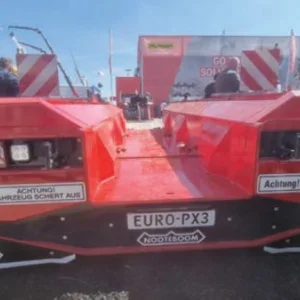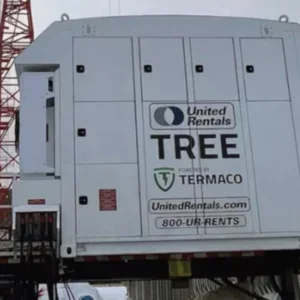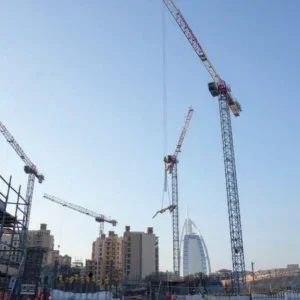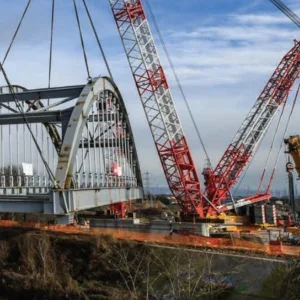Four years ago, the biggest crawler at Bauma China was a 280t capacity LR 280, says Dong Yang, the general manager of crawler sales for Liebherr Nenzing’s Shanghai office.
Not so in November 2006, when no fewer than five crawler cranes from Chinese manufacturers were there.

Left to right: Liebherr LR 1400/1, Zoomlion QUY 600 with luffing boom and XCMG QUY 450 crawlers at Bauma China 2006
At Bauma China 2006, Liebherr’s LR 1400/1 seemed lost next to the biggest of them all, the new 600t Puyuan Zoomlion QUY 600, with its 138m main boom and 36m luffing jib.

Zoomlion QUY 600 crawler crane upper at Bauma China 2006
Next up, size-wise, was XCMG’s 450t QUY 450, then Sany’s 400t SCC 4000, Fushun Excavator Corp’s 350t QUY 350, and Sany’s 260t SCC 2500.
“The crawler crane is the brightest of the hot spots in the crane industry in 2006,” according to the China Construction Machinery Association’s 2006 annual report, published in a tabloid magazine at the show.
Partly, the cranes are a Chinese response to local construction demand. The report continues: “With China’s sustained and rapid economic development, especially the 11th five-year plan proposed, the state and enterprises have increased investment in energy and infrastructure construction, such as nuclear power, thermal energy, wind power, metallurgy, petroleum, chemicals, large bridges, high-speed railways, large stadiums, etc.
“They have greatly stimulated the demand for crawler cranes, especially the large crawler cranes, making the large hoisting market unprecedentedly prosperous, thus bringing an unprecedented opportunity for the hoisting equipment industry,” the report says.
It is an opportunity that has only recently been realised. The oldest of the bunch—the Sany SCC 4000—was only working in June 2006. One of the newest, the XCMG, is not yet ready for sale at the time of publication.

Rear view of Sany SCC 4000 crawler crane at Bauma China 2006
Most of them are designed to carry as much as they can. Three—the Zoomlion, the XCMG and the larger Sany—can carry backmasts with extra counterweight trays (although the XCMG model was shown without one). Sany’s SCC4000 claimed to be the first Chinese crawler with a derrick boom.

XCMG QUY 450 crawler crane at Bauma China 2006
All five cranes have the option of heavy-lift boom. The cranes’ main booms are generally about 100m (330ft) long, and combinations of luffing jibs—locally known as towering jibs—were about 70m+70m long (230ft). Maximum lifting speeds were above 130m/min (425fpm). Most engines were about 300kW (225 hp) and the lightest transportable units were mostly above 50t (55 US tons). Fushun, Sany and XCMG all mention using imported major components.
In the cases of Zoomlion and XCMG, at least, the list of imported components includes specialist high-strength steel. As western crane manufacturers know all too well, this vital ingredient is in short supply worldwide. “The biggest headache we have is the lead time of overseas suppliers,” Zhang Jianguo, executive president, Changsha Zoomlion, told Cranes Today. “For Chinese suppliers it is okay. But our demand is a small portion of their total production. We are waiting 16 months for high-strength steel.”
Partly, the appearance of the cranes seems to be a statement to the world that the Chinese can do more than copy the West.
Although the market for large crawlers may be strong, it is not large. The biggest portion of the Chinese market is from 60t to 250t, Zhang Jianguo, says, and in China there are very few cranes above 1,000t capacity.
He called the 600-tonner “a demonstration of Zoomlion ability.” He adds: “It is a show of accumulated technology.” The crane has already been sold to Anshan Steel Construction Group.

Fushun QUY 350 crawler crane at Bauma China 2006
In a brochure, Fushun Excavator Corp describes its QUY 350 as having “integrated years of manufacturing experience and technical distillate with the most advanced international front-line strategy. The technical capacity and parameters of this module are equal to the international products of the same kind. Its lifting capacity even exceeds that of some of the imported products.” This crane has been sold to the Baogang Group.
The fight with imports
Chinese manufacturers fight particularly hard against foreign cranes. To date, imported and domestic cranes have faced each other from opposite ends of the spectrum: imports dominate the large capacities and domestics the large numbers. Importers estimate that they have the advantage with cranes that are above capacities of between 150t and 200t—Dong Yang of Liebherr Nenzing estimates 150t, Hitachi-Sumitomo’s Japanese sales promotion secretary Hayato Takebe estimates 200t. Either way, these large crawlers are shots deep into enemy territory.
According to the CCMA’s annual report, China’s crawler crane imports are falling. In 2004, 268 were imported, in 2005, 179, and in the first half of 2006 there were only 50. It said that the 179 crawlers bought in 2005 were worth a total of RMB 1.52bn ($191.5m), or an average of $1.07m each. Takebe estimates the total Chinese crawler crane market at about 350 units per year.
These large cranes may further reduce imports: directly, by offering local competition for the big German and American crawlers, and possibly indirectly as well. The Chinese government requires Chinese customers to pay an import licence for cranes that are an equivalent size and type to those already available from domestic manufacturers. This licence costs 10% of the purchase price of the crane, according to Zhai Zhiqiang, Liebherr Machinery Service (Shanghai) mobile crane division sales manager.
Most of the people contacted for this article agree that the presence of domestic competition will not lead to greater import tariffs for crawlers in the future. In other words, despite the theories of some people, it is unlikely that Chinese domestic manufacturers are manipulating the tax system to price competing foreign cranes out of the domestic market.
The import tariff is applied mainly to small- and medium-duty cranes, according to Yong Ming Shen, secretary-general of the Engineering Crane Bureau of the China Construction Machinery Association.
The import duty is applied before 17.5% tax. Questions remain about how much tax will need to be paid on imported crawlers in the future.

Visitors shelter under Zoomlion QUY 600 upper counterweight at Bauma China 2006
“The Chinese government will not increase the tax,” Zhiqiang says. “China is a member of the World Trade Organisation, so it is not right to increase the tax. But the government will control the tax fee for importation of the cranes from other countries, meaning that it will be very difficult to get duty free overseas cranes for Chinese companies.”
His opposite number at Terex-Demag disagrees. “The import license was existing for nearly all models in the past already,” says Thomas Veith, sales manager of Terex-Demag’s Beijing Representative Office. “But the crane users were able to get a duty free import license for important projects and it was quite easy to get one. I don’t think that it will be much more difficult to get an import license for big crawler cranes in the future.”
According to Veith, Chinese manufacturers are building big to cater for a big opportunity in the global construction market. He adds: “I think by the end of the year the Chinese manufactures have one big advantage, and that is availability.”
In 2007 Chinese crawler makers will not let up the pressure, as they launch still-bigger cranes currently on the drawing board. Zoomlion’s designs for a thousand-tonner are only waiting for a customer, Jiangguo says. Fushun Excavator Corp says an 800-tonner will be out mid-year. The CCMA annual report also predicts a 650t XCMG and 900t Sany crawler in 2007.






